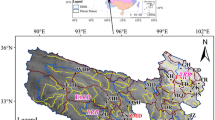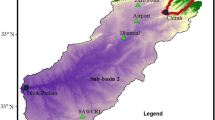Abstract
In this study, the calibration and validation period with stable underlying surface conditions was determined by using a statistically significant change point of the annual streamflow in several catchments of the Wei River basin (WRB). The effects of climate changes and human activities on streamflow were estimated by using the sensitivity-based method and the dynamic water balance model, respectively. The contributions of climate effects and human activities effects on streamflow were also investigated. The results showed that almost all the catchments exhibited significant decreasing trend of streamflow in the early 1990s. The streamflow was more sensitive to changes in precipitation than changes in potential evapotranspiration (PET). Effects of climate due to changes in precipitation and PET are weak in Linjiacun, Weijiabao and **anyang catchments, while it is strong in the catchments controlled by other hydrological stations, accounting for more than 40 % of streamflow reduction. Effects of human activities on streamflow in Linjiacun, Weijiabao, **anyang and Zhangjiashan catchments accounted for more than 50 % of the streamflow reduction. The study provides scientific foundation to understand the causes of water resources scarcity and useful information for the planning and management of water resources in the ecological fragile arid area.



Similar content being viewed by others
References
Allen RG, Pereira LS, Raes D, Smith M (1998) Crop evapotranspiration: guidelines for computing crop water requirements. FAO, Rome
Christensen NS, Wood AW, Voisin N, Lettenmaier DP, Palmer RN (2004) The effects of climate change on the hydrology and water resources of the Colorado River basin. Clim Change 62(1):337–363
Daughney CJ, Reeves RR (2006) Analysis of temporal trends in New Zealand’s groundwater quality based on data from the National Groundwater Monitoring Programme. J Hydrol 45(1):41–62
Deng ZY, Zhang Q, Li DL, Zhu YJ, Dong AX, Zhang Y (2006) Influence of climate change on runoff and sediment discharge in upriver area of Weihe River. J Desert Res 26(6):982–985 (in Chinese)
Dooge JCI, Bruen M, Parmentier B (1999) A simple model for estimating the sensitivity of runoff to long-term changes in precipitation without a change in vegetation. Adv Water Resour 23(2):153–163
Hao XM, Chen YN, Xu CC, Li WH (2008) Impacts of climate change and human activities on the surface runoff in the Tarim River basin over the last fifty years. Water Resour Manag 22(9):1159–1171
He HM, Zhang QF, Zhou J, Fei J, **e XP (2009) Coupling climate change with hydrological dynamic in Qinling Mountains, China. Clim Change 94(3–4):409–427
He XB, Li ZB, Hao MD, Tang KL, Zheng FL (2003) Down-scale analysis for water scarcity in response to soil-water conservation on Loess Plateau of China. Agr Ecosyst Environ 94(3):355–361
Hirsch RM, Slack JR, Smith RA (1982) Techniques of trend analysis for monthly water quality data. Water Resour Res 18(1):107–121
Huo ZL, Feng SY, Kang SZ, Li WC, Chen SJ (2008) Effect of climate changes and water-related human activities on annual stream flows of the Shiyang river basin in and north-west China. Hydrol Process 22(16):3155–3167
Jhajharia D, Shrivastava SK, Sarkar D, Sarkar S (2009) Temporal characteristics of pan evaporation trends under the humid conditions of northeast India. Agr Forest Meteorol 149(5):763–770
Jiang SH, Ren LL, Yong B, Singh VP, Yang XL, Yuan F (2011) Quantifying the effects of climate variability and human activities on runoff from the Laohahe basin in northern China using three different methods. Hydrol Process 25(16):2492–2505. doi:10.1002/hyp.8002
Jones RN, Chiew FHS, Boughton WC, Zhang L (2006) Estimating the sensitivity of mean annual runoff to climate change using selected hydrological models. Adv Water Resour 29(10):1419–1429
Kang LL, Wei YC, Zhang SL, Liu XQ (2009) Hydrological analysis for the cause of recent change of water and sediment in the Beiluohe River basin. J Water Resour Water Eng 20(5):41–48 (in Chinese)
Karabork MC, Kahya E, Komuscu AU (2007) Analysis of Turkish precipitation data: homogeneity and the Southern Oscillation forcings on frequency distributions. Hydrol Process 21(23):3203–3210
Kendall MG (1975) Rank correlation measures. Charles Griffin, London
Klemeš V (1986) Operational testing of hydrological simulation models. Hydro Sci J 31(1):13–24
Koster RD, Suarez MJ (1999) A simple framework for examining the interannual variability of land surface moisture fluxes. J Clim 12(7):1911–1917
Kulkarni A, Von Storch H (1995) Monte Carlo experiments on the effect of serial correlation on the Mann-Kendall test of trend. Meteorol Z 4(2):82–85
Legates DR, McCabe GJ Jr (1999) Evaluating the use of “goodness-of-fit” measures in hydrologic and hydroclimatic model validation. Water Resour Res 35(1):233–241
Li LJ, Zhang L, Wang H, Wang J, Yang JW, Jiang DJ, Li JY, Qin DY (2007) Assessing the impact of climate variability and human activities on streamflow from the Wuding River basin in China. Hydrol Process 21(25):3485–3491
Ma ZM, Kang SZ, Zhang L, Tong L, Su XL (2008) Analysis of impacts of climate variability and human activity on streamflow for a river basin in arid region of northwest China. J Hydrol 352(3–4):239–249
Mann HB (1945) Nonparametric tests against trend. Econometric 13(3):245–259
Martinez MD, Serra C, Burgueno A, Lana X (2010) Time trends of daily maximum and minimum temperatures in Catalonia (ne Spain) for the period 1975–2004. Int J Climatol 30(2):267–290
Mavromatis T, Stathis D (2011) Response of the water balance in Greece to temperature and precipitation trends. Theor Appl Climatol 104(1–2):13–24
Milly PCD, Dunne KA (2002) Macroscale water fluxes, 2, Water and energy supply control of their interannual variability. Water Resour Res 38(10):1206. doi:10.1029/2001WR000760
Modarres R, Da Silva V (2007) Rainfall trends in arid and semi-arid regions of Iran. J Arid Environ 70(2):344–355
Myronidis D, Stathis D, Ioannou K, Fotakis D (2012) An integration of statistics temporal methods to track the effect of drought in a shallow Mediterranean Lake. Water Resour Manag 26(15):4587–4605
Naik PK, Jay DA (2011) Distinguishing human and climate influences on the Columbia River: changes in mean flow and sediment transport. J Hydrol 404(3–4):259–277
Pettitt AN (1979) A non-parametric approach to the change-point problem. Appl Stat 28(2):126–135
Schaake JCJ, Liu CZ (1989) Development and application of simple water balance models to understand the relationship between climate and water resources. IAHS Publ 181:343–352
Sen PK (1968) Estimates of the regression coefficient based on Kendall’s tau. J Am Stat Assoc 63(324):1379–1389
Song JX, Xu ZX, Liu CM, Li HE (2007) Ecological and environmental instream flow requirements for the Wei River - the largest tributary of the Yellow River. Hydrol Process 21(8):1066–1073
Su XL, Kang SZ, Wei XM, **ng DW, Cao HX (2007) Impact of climate change and human activity on the runoff of Wei River basin to the Yellow River. J Northwest A & F Univ (Nat Sci Ed) 35(2):153–159 (in Chinese)
Thiessen AH (1911) Precipitation averages for large areas. Mon Weather Rev 39(7):1082–1089
Wang GS, **a J, Chen J (2009) Quantification of effects of climate variations and human activities on runoff by a monthly water balance model: a case study of the Chaobai River basin in northern China. Water Resour Res 45, W00A11. doi:10.1029/2007WR006768
Wang JH, Hong Y, Gourley J, Adhikari P, Li L, Su FG (2010) Quantitative assessment of climate change and human impacts on long-term hydrologic response: a case study in a sub-basin of the Yellow River, China. Int J Climatol 30(14):2130–2137
Wei HY, Li J, Wang J, Tian P (2008) Analysis on runoff trend and influence factors in Weihe River basin. Bull Soil Water Conserv 28(1):76–80 (in Chinese)
Xu CY (2000) Modelling the effects of climate change on water resources in central Sweden. Water Resour Manag 14(3):177–189
Xu JX (2011) Variation in annual runoff of the Wudinghe River as influenced by climate change and human activity. Quatern Int 244(2):230–237
Xu ZX, Takeuchi K, Ishidaira H, Li JY (2005) Long-term trend analysis for precipitation in Asian Pacific FRIEND river basins. Hydrol Process 19(18):3517–3532
Yang H, Jia SF (2008) Meeting the basin closure of the Yellow River in China. Int J Water Resour D 24(2):265–274
Yue S, Pilon P, Phinney B, Cavadias G (2002) The influence of autocorrelation on the ability to detect trend in hydrological series. Hydrol Process 16(9):1807–1829
Zhang AJ, Zhang C, Fu GB, Wang BD, Bao ZX, Zheng HX (2012) Assessments of impacts of climate change and human activities on runoff with SWAT for the Huifa River Basin, Northeast China. Water Resour Manag 26(8):2199–2217
Zhang L, Dawes WR, Walker GR (2001) Response of mean annual evapotranspiration to vegetation changes at catchment scale. Water Resour Res 37(3):701–708
Zhang L, Potter N, Hickel K, Zhang YQ, Shao QX (2008) Water balance modeling over variable time scales based on the Budyko framework - Model development and testing. J Hydrol 360(1–4):117–131
Zhang YF, Guan DX, ** CJ, Wang AZ, Wu JB, Yuan FH (2011a) Analysis of impacts of climate variability and human activity on streamflow for a river basin in northeast China. J Hydrol 410(3–4):239–247
Zhang SL, Wang YH, Yu PT, Zhang HJ, Tu XW (2011b) Impact of human activities on the spatial and temporal variation of runoff of **ghe Basin, Northwest China. J Arid Land Resour Environ 25(6):66–72 (in Chinese)
Zhao FF, Xu ZX, Zhang L, Zuo DP (2009) Streamflow response to climate variability and human activities in the upper catchment of the Yellow River Basin. Sci China Ser E: Technol Sci 52(11):3249–3256
Zuo DP, Xu ZX, Yang H, Liu XC (2012) Spatiotemporal variations and abrupt changes of potential evapotranspiration and its sensitivity to key meteorological variables in the Wei River basin, China. Hydrol Process 26(8):1149–1160
Acknowledgments
This study is jointly supported by the National Natural Science Foundation of China (Grant No. 51309010, 51279005), the National Key Technologies R&D Program (Grant No. 2013BAC05B04), and the Fundamental Research Funds for the Central Universities (Grant No. 2013NT46). The authors would like to thank the editor-in-chief, Professor George P. Tsakiris and three anonymous reviewers for their useful and constructive comments and suggestions which have substantially improved the quality of this manuscript.
Author information
Authors and Affiliations
Corresponding author
Rights and permissions
About this article
Cite this article
Zuo, D., Xu, Z., Wu, W. et al. Identification of Streamflow Response to Climate Change and Human Activities in the Wei River Basin, China. Water Resour Manage 28, 833–851 (2014). https://doi.org/10.1007/s11269-014-0519-0
Received:
Accepted:
Published:
Issue Date:
DOI: https://doi.org/10.1007/s11269-014-0519-0




